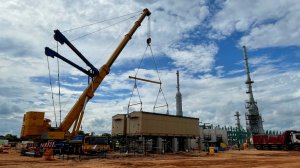

E-houses installed to power Mozambique gas project









An important substation E-house facility at Sasol’s Upstream Production Sharing Agreement (PSA) Project in Mozambique has relied on WEG Africa’s depth of experience
One of the WEG E-house pods being offloaded on site
One of the WEG E-house pods being rigged into place
Rigging the first WEG E-house pod into position on site
The second WEG E-house pod being lowered into position
WEG Africa considered the elevation and environmental weather conditions to ensure the E-house solution will withstand the harshest conditions
The front entrance of the fully assembled WEG E-house solution
The WEG E-house option overcomes the various challenges of building conventional electrical facilities on-site in countries with limited infrastructure
Now in the final stages of installation and commissioning, an important substation E-house facility at Sasol’s Upstream Production Sharing Agreement (PSA) Project in Mozambique has relied on WEG Africa’s depth of experience, locally based technical infrastructure and specialised skill sets.
The E-house solution with transformers and generator set, procured by EPCM contractor Wood, was locally designed and manufactured by WEG Africa and supplied in partnership with local engineering firm Proconics.
“The project has been a successful demonstration of our product quality and technological capacity, delivered to the highest global standards,” says Lukas Barnard, WEG Africa’s Sector Specialist Oil and Gas - Business Development. “Our scope of supply was really the ‘electrical heart’ of the project – with the electrical supply and control for the entire PSA plant coming through the E-houses.”
The PSA Project includes the construction of facilities to produce 23 million gigajoules of gas/annum, which will power the Temane Thermal Power Plant (CTT) to generate 450MW of electricity and excess gas for export. It will also include a Liquefied Petroleum Gas (LPG) facility that will produce 30,000 tons per year, meeting 75% of Mozambique’s cooking gas demand, as well as light oil for export. The substation package measures 45 m by 22 m and includes medium voltage (MV) and low voltage (LV) switchgear, a battery room, a local equipment room and an HVAC system.
Barnard highlighted how the E-house option overcomes the various challenges of building conventional electrical facilities on-site in countries with limited infrastructure. WEG Africa could manufacture and pre-assemble the E-houses under controlled workshop conditions at its advanced facility in Heidelberg, Gauteng. The design also responded to the harsh environmental conditions and other risks on the site.
“The site for which the E-house solution has been designed is in a region which has experienced multiple hurricanes in the past,” Barnard says. “WEG Africa also considered the elevation and environmental weather conditions to ensure the E-house solution will withstand the harshest conditions.”
Special treatment of the steel was necessary to ensure the high level of corrosion protection required by the client. All related work was conducted in accordance with SANS 12944 for C5M – or highly corrosive – environments. Outer walls are constructed from 3CR12 stainless steel, with galvanised steel for outside staircases and walkways. Another design element which the structure includes is its ability to resist seismic events with ground acceleration of up to 0.20g – the measure of g-force or ground acceleration.
The conducive workshop conditions for constructing the E-houses – and the ready access to the necessary expertise – facilitated strict adherence to WEG Africa’s manufacturing quality standards, which are aligned to ISO 9001. Barnard notes that this also allowed for greater manufacturing efficiency, while reducing the number of people required on site; improving safety levels and minimising the risk of construction-related incidents.
“The whole package, with all the relevant equipment, could be transported to site,” he explains. “Even though the logistics were challenging, this method greatly reduced the complexity and timeline, due to all the equipment already being installed and tested.”
He reiterates that this project combined the manufacturing capabilities of WEG Africa and the project management and design capabilities of Proconics. This demonstrates that the partnership the two companies have built can provide full turnkey solutions to the oil and gas industry.
“Working closely with the contractor, WEG Africa and Proconics ensured all the client expectations were met, and the highest quality of workmanship delivered,” he says. “The success of a project like this also sends a clear message to the market that the necessary expertise and industrial capabilities are right here in South Africa.”
He says the experience gained from this project has proved that WEG Africa in well positioned to execute similar projects in the energy sector. The success with which project challenges were overcome also generated important lessons that can be carried into future projects.
“WEG Africa’s portfolio in the energy sector is growing steadily, which is good news in terms of responding to the country’s current energy challenges,” he concludes.









